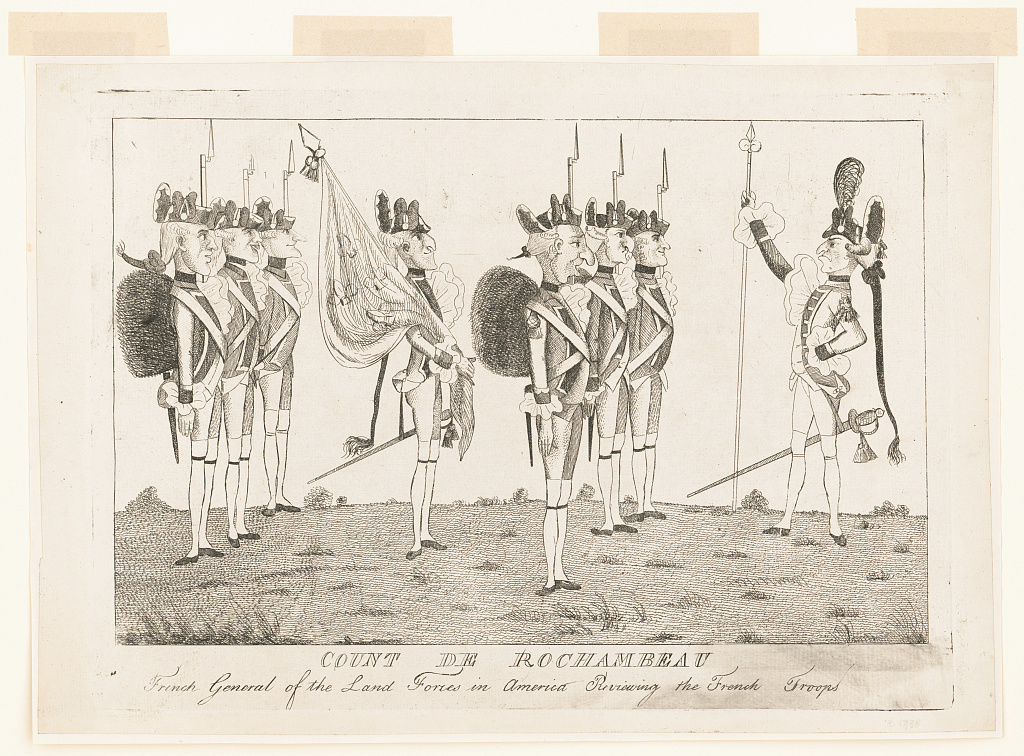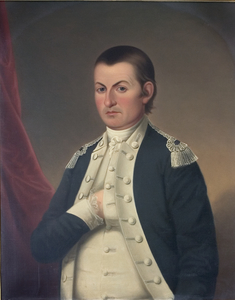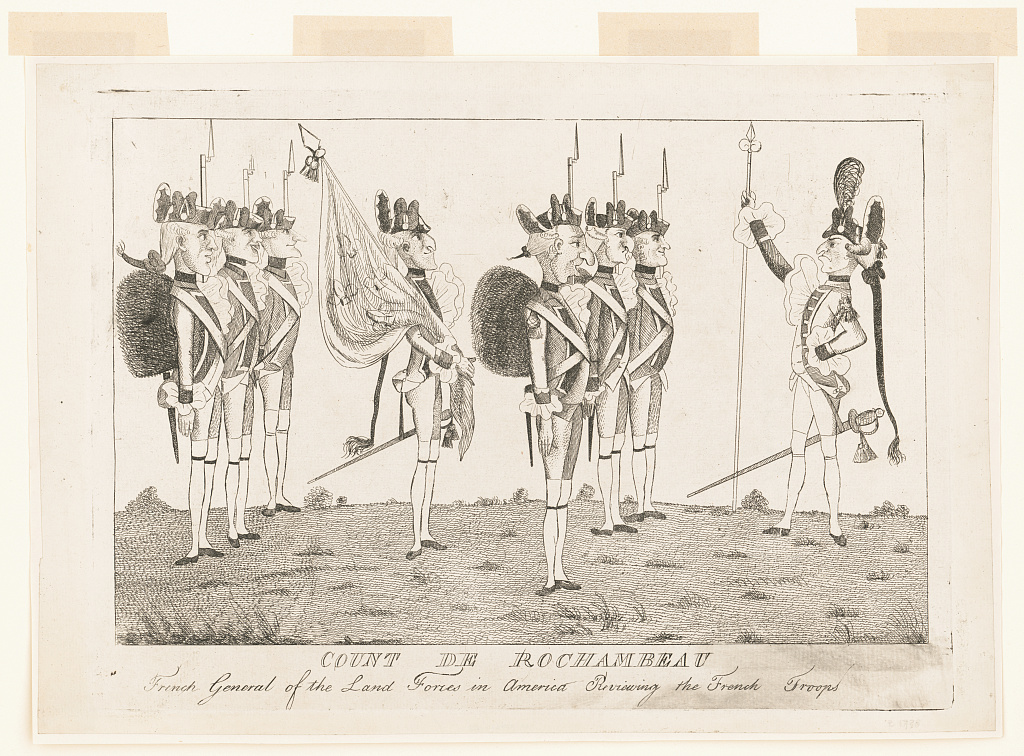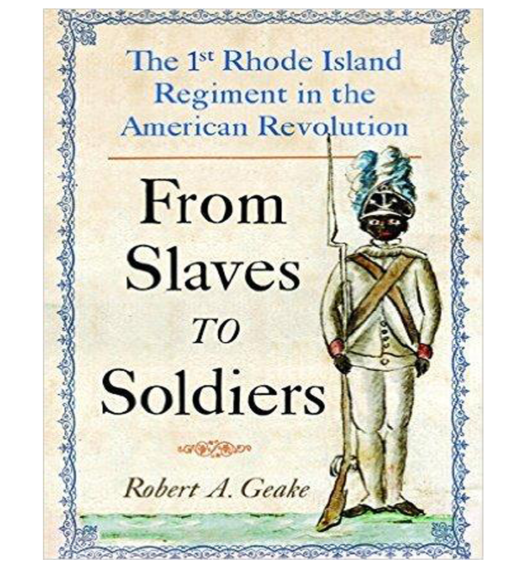With the Naval War College on Aquidneck Island, we island residents have a familiarity with the idea of “wargaming” or rehearsing the decisions leaders would make during warfare involving joint military operations. Wargaming did not begin with the War College in the 1870s. While the French were on the island during the American Revolutionary War from 1780 to 1782, they held “mock battles” by Woods Castle in the Third Beach area of Middletown.[1]
In researching the French and American collaboration in the construction of Butts Hill Fort from July 1780 to September 1781, I came across a letter, dated October 16, 1780, written by Dr. John Goddard. Goddard, born in Brookline, Massachusetts, was then stationed at Butts Hill, probably with a Massachusetts militia regiment.[2] The letter vividly describes a “Sham Battle” or training exercise between the French and American forces on Aquidneck Island on October 2, 1780. At the time, the French forces were commanded by the comte de Rochambeau, while the American forces were commanded by Colonel Christopher Greene of Warwick.
The part of Goddard’s letter dealing with the mock battle is set forth immediately below (slight corrections to grammar, spelling and punctuation have been made):
I had like to have forgot to mention a famous Sham Battle on the 2d Inst [i.e., on the second of October] between a party of the French Troops on one part representing the English [i.e., the British army] & the Continental Regt reinforced by a party of the French and the German Line representing the allied [French and American] Armies. The particulars I have not time to give you in full, [so I] shall only mention a few of the principals, Maj. Gen’l Vianumino [Charles Joseph Hyacinthe du Houx de Vioménil] second in Command in the French Army [under Rochambeau] commanded the English who landed at Stoddard’s Farm & marched up & attacked Col. Greene’s Reg’t.[3]
Let’s pause here for a moment. The American regiment called “Col. Greene’s Reg’t” is the First Rhode Island Regiment of the Continental Army. It was also known as the “Black Regiment.” It was still a segregated regiment at this time, with men of color serving as the privates and musicians, and white men serving as corporals, sergeants, and officers. The men of color were mostly formerly enslaved men who had obtained their freedom by enlisting in the regiment in the first half of 1778. There were also plenty of men of color who were free when then enlisted—some of whom enlisted and saw combat in 1777. These men included not only Blacks, but also Indians and men of mixed Indian and white parents and Indian and Black parents. The rank and file at the time numbered about 130 soldiers. These men were veterans.[4] Moreover, at the time, the First Rhode Island had annexed to it about 530 men who had enlisted for a term of six months. These “six months men” were mostly Whites, but 65 of them were men of color. The six months men participated in the battle too along with the First Rhode Island.[5] Colonel Greene’s regiment was, Goddard wrote, “reinforced by a party of the French and German Line representing the allied Armies.” Here Goddard refers to German troops; these were soldiers who were Germans but who had voluntarily enlisted in, and were part of, the regular French army.[6]
Next, Goddard describes the mock battle itself in wonderful detail:
The line began with skirmishing between the Flank Guards, light horse &cc. Soon after a heavy cannonade on the part of the “British” obliged Col. Greene to retreat & form his Reg. behind a Wall [i.e., a stonewall] where the resistance was obstinate & a constant fire kept uphill. Col. Greene was reinforced with about 2000 French & Germans commanded by his Excellency Count de Rochambeau with 12 pieces of Cannon. A severe conflict ensued in which the British gave way [and] were finally surrounded & all made prisoners. The Action lasted about two hours during which a constant heavy fire was kept up. If I have any just Idea of a real Action this very nearly resembles it.[7]
One wonders how the inhabitants of Middletown and Portsmouth reacted to such a loud and vivid battle in their midst, with the constant racket of musket fire and booms of the cannon. Stoddard’s Farm was just over the Middletown line off of West Main Road and the “battle” seemed to move through the west side of Portsmouth and uphill towards Turkey Hill and Butts Hill.
There are other accounts of this “sham battle, a few of which I will mention here. Dr. Robert A. Selig in the archives of the w3r project wrote: “Following Rochambeau’s return from Hartford, the army on 1 and 6 October practiced defending against a British Landing in the vicinity of an unidentified location called ‘Statlers House’ by Closen and ‘Staderhouse’ by the comte de Lauberdière.”[8]
Thus, Dr. Selig mentions two different sham battles occurring in early October, one on October 1 and one on October 6. Selig relies on for those two dates a journal kept by Baron Ludwig von Closen.[9]
Goddard’s letter puts the date of the battle he witnessed as October 2nd. They were practicing defending against a British landing in the same place the British army had first landed in its invasion of Aquidneck Island in December of 1776. British captain Frederick Mackenzie’s diary entry for December 8, 1776 includes the following about the landing: “The Army landed this morning at Weaver’s Cove near Mr. Stoddard’s house…”[10]

The location of Stoddard’s House is highlighted with the cursor. The house marked “Overings” is the Henry Overing House, on West Main Road, where British Major General Richard Prescott was captured by Lieutenant Colonel William Barton of Rhode Island in a surprise nighttime raid conducted in July 1777. An excerpt from a map by Edward Fage, “Plan of Rhode Island, the Harbour, the Adjacent Islands, and Coast,” British Map, 1778, Norman B. Leventhal Map & Education Center, https://collections.leventhalmap.org/search/commonwealth:hx11z3134 (accessed October 2, 2024).
The October 11, 1780, edition of the Providence Gazette also mentions the sham battle as occurring October 2nd: “The same day [October 2], a Mock-Battle was fought in Rhode Island between a Detachment of His Most Christian Majesty’s troops and Col. Greene’s Continental Regiment which afforded much satisfaction to the Spectators.”
Von Closen’s description of the October 2 mock battle lacks the detail found in Goddard’s letter. Von Closen wrote: “there was a mock battle near Statlers [i.e., Stoddard’s] House . . . where the enemy was likely to attempt a landing. The enemy was represented by some launches [small boats]. It [the mock enemy] was forced to re-embark [onto the launches] under the fire of some batteries and columns [of infantry], which rushed up at the charge.” Of the next mock battle several days later, Closen wrote even less detail: “The same maneuver was repeated on the 6th with much more coordination.”[11] Apparently, Goddard missed this second mock battle.
Rhode Island historian Norman Desmarais has translated and had published the journal kept by the comte de Lauberdière. The French officer described the second mock battle, which he has occurring on October 8. He provides more detail than Closen, but his journal entry too lacks the vivid detail provided by Goddard.

The Comte de Rochambeau, commander of the French armed forces in Newport, 1780-81 (Library of Congress)
Lauberdière wrote, “The [French] soldiers under canvas [i.e., camping under tents] want to see the enemy, want to hear the cannon. In the absence of the British, Mr. de Rochambeau created some . . . [O]n the eighth [October 8th] he drilled the army on the point where the real enemy might land. We pretended that a fleet entered our harbor and planned a landing.” The French officer continued:
We put 1500 men under the command of the Viscount de Vioménil who was at Stauder’s [Stoddard’s] house. It was there that our enemies first began to take possession of a few houses along the shore [. i.e., the British army in December 1776]. Mr. de Rochambeau kept the rest of the troops with him for the imminent attack to which he joined the American Rhode Island Regiment commanded by Col. Greene. These troops were divided into two columns. Mr. de Rochambeau personally led the left column. The Baron de Vioménil commanded the right. The grenadier and light infantry battalions formed a separate one.
The attack began with several discharges of cannon, well-executed to create a complete effect of the fictitious enemy leaving their boats and forming quickly [i.e., the pretend British invaders under Vioménil form at Stoddard’s house, as if they had just landed from Royal Navy ships]. At the same time, the column of grenadiers advanced to dislodge the enemy from the houses as they began to establish themselves there. During this musket fire, the Baron de Vioménil turned their right under the protection of a hill which concealed his movement. When he was ready and the attack was fully engaged, Mr. de Rochambeau had the charge sounded. Everything advanced in good order. The enemy disappeared [i.e., the troops under Vioménil retreated] and reassembled on the seashore [i.e., as if to return to their boats].[12]
Lauberdière mentioned a tragic accident occurring during the second mock battle. The French officer wrote, “A cannoneer cleaning a piece lost an arm by the sponge. The one who was aiming it [the cannon] had neglected to cover the touchhole with his thumb. An ember remaining from the preceding hot shot ignited and the charge caught fire.”[13]
The w3r archive also provides a short description of one of the mock battles by a Continental soldier from Connecticut, Jacob Meech. In his pension application, dated June 30, 1834, Meech stated that he had served in the First Rhode Island Regiment as a “six months man” starting July 1, 1780. He also said that he worked on the Butts Hill Fort and later served as a guard at Quaker Hill, bunking in the Quaker meeting house there. Meech also recalled that, “in 1780 at Rhode Island Genl Rochambeau was there” and that “a sham fight was performed by the French Troops, in which the American Regt in which declarant served took part as a Flank Guard to the party impersonating the French.”[14]

“Count de Rochambeau, French General of the Land Forces in America Reviewing the French Troops” (Library of Congress)
In his letter, Goddard describes the Sham Battle as “famous”, but it was unknown to me in 2021 when I began to research the timeline for Butts Hill Fort. The “Camp Butts Hill” era for the fort was from 1780 to 1781 when American forces were aiding the French in building the fort into the shape we know it today.
I first came across the name of Dr. John Goddard as I was transcribing Colonel Ebenezer Thayer’s Orderly Books for his Massachusetts regiment, when they were stationed at Camp Butts Hill in 1780. The orderly books provide a glimpse of what was happening day-to-day at the fort. One of the last entries was about a court martial of Stephen Fuller, who was accused of abusing Dr. John Goddard.[15] I frequently search for information on soldiers mentioned in the orderly books. An internet search for “Dr. John Goddard” and “Camp Butts Hill” led me to a recent advertisement for the sale of a letter Goddard wrote from Camp Butts Hill. The letter is dated October 16, 1780 and was sent to Dr. Clement Storer. The description of the letter mentioned that the letter’s general aim was for Storer to find Goddard a post as a surgeon for a voyage.
Part of the letter was transcribed and included in the ad. My interest was piqued by the description of the troops on Aquidneck Island and the description of the training exercise. I had taken a screenshot of the letter from the ad and I could transcribe the opening paragraphs. Dr. Goddard wrote that he had “engaged in the Service of the public for three months.” This was a typical time commitment for the militias working at Camp Butts Hill. He was hoping that his friend would find him a position as a ship’s surgeon for free passage to Europe. He commented that he was writing a quick letter because the “gentleman who forwards this [letter] is waiting with the greatest impatience” so he would just give “a sketch of our situation and strength.” The next paragraph provides a glimpse of the military situation on Aquidneck Island and the strength of the troops (again, minor grammar, spelling and punctuation corrections have been made).
. . . there are about 7500 Men on the Island at the Several ports, 5000 of which are French, at Newport, 2000 Three Months Men at this place, and 500 Continentals under Col. Greene of this state [i.e., Rhode Island] stationed at Stoddard’s Farm 3 miles from Newport [to the] Northwest. Notwithstanding the Superiority of the English Fleet, the French appear to feel very secure. Their Fleet consisting of seven sail of the Line & three Frigates are drawn up in line of Battle from Tomany [Miantonomi] Hill across the Channel [i.e., the Main Channel of Narragansett Bay, what is now the East Passage] to Conanicut [i.e., Conanicut Island, also known as Jamestown]. The Town of Newport is surrounded with Forts which are well filled with Cannon. On the whole I believe there is no Reason to fear an Attack from the Enemy this season.[16]

Colonel Christopher Greene of the First Rhode Island Regiment by James Sullivan, based on a contemporary drawing (Brown University Portrait Collection)
The description of the First Rhode Island as having 500 Continentals must have included the newly-raised “six months men.” The 2,000 “three months men” were mostly all in Massachusetts militia or state regiments. Both sets of soldiers helped to construct Butts Hill Fort.
Goddard‘s comments about being in a hurry lead me to believe there was little in the letter beyond the description of the forces and sham battle. Although Goddard held the belief that “there is no Reason to fear an Attack from the Enemy this season,” the mock battles were an opportunity to sharpen the skills of the joint allied armies—just in case.
As I provide notes on references below, sadly I cannot provide a link to Goddard’s letter. Since I first saw it in 2021 the letter has been presumably sold and the website advertisement has disappeared. I have been unable to trace the location of the letter, which may be in the hands of a private collector. Still, through serendipity I came across an interesting addition to our knowledge of what was going on during the days when the French military occupied Aquidneck Island.
[The author thanks Christian McBurney for providing information on the First Rhode Island Regiment and the “six months men,” and for providing the quotes from Closen and Lauberdière.]Footnotes:
[1] See Norman Desmarais, “Why Newport Scorned the French in 1780,” Online Review of Rhode Island History, accessed in 2024, https://smallstatebighistory.com/why-newport-scorned-the-french-in-1780/. [2] Dr. John Goddard to Dr. Clement Storer, October 16, 1780, posted at William Reese auction website, accessed 2021 at /https:www.williamresecompany.com [no longer accessible] [3] Ibid. [4] For soldiers of color in the Rhode Island Continental Regiments fighting at the Battle of Red Bank and the Battle of Rhode Island, see Robert Geake, From Slaves to Soldiers, The 1st Rhode Island Regiment in the American Revolution (Yardley, PA: Westholme, 2016), 13-15 and 46-58; Shirley L. Green, Revolutionary Backs, Discovering the Frank Brothers, Freeborn Men of Color, Soldiers of Independence (Yardley, PA: Westholme, 2023), 58-102. [5] See Roll of Recruits Mustered for the Rhode Island Line, July 1780, in Military Papers, Revolutionary War, vol. 9, 121-33, Rhode Island State Archives. [6] See Robert A. Selig, “The March to Philipsburg, 11 June to 6 July 1781, Preparations for the March/Departure from Newport,” in The Washington-Rochambeau Revolutionary Route in the State of Rhode Island, 1780-83, An Architectural and Historical Site Survey and Resource Inventory (2006, updated 2015),W3Archives, at http://w3r-archive.org/history/library/seligreptri3a.pdf, page 225 (accessed October 2, 2024). [7] Same cite as footnote 2 above. [8] See Robert A. Selig, “Supplying Rochambeau’s Army . . . .,” The Washington-Rochambeau Revolutionary Route in Rhode Island, at http://w3r-archive.org/history/library/seligreptri2b.pdf, page 159, accessed June 30, 2024. [9] Journal Entry, December 8, 1776, in Frederick Mackenzie, Diary of Frederick Mackenzie, vol. 1 (Cambridge, MA: Harvard Press, 1930), 123. [10] Journal Entry, October 1780, in Evelyn M. Acomb, ed., The Revolutionary Journal of Baron Ludwig von Closen, 1780-1783 (Chapel Hill, NC: University of North Carolina Press, 1958), 42. Another French officer, Claude Blanchard, wrote that the two mock battles took place on October 2 and 7. Ibid., n. 27. [11] Ibid. [12] Journal Entry, October 1780, in Norman Desmarais, ed., The Road to Yorktown, The French Campaigns in the American Revolution, 1780-1783, by Louis-Francoise-Bertrand du Pont d’Aubevoye, comte de Lauberdière (Yardley, PA: Westholme, 2021), 41. [13] Ibid. [14] See Jacob Meech Sworn Declaration, June 30, 1824, Jacob Meech Pension Application, S15524, National Archives. Meech further recalled that the six months men included “a company of Blacks” under Captain Stevens. Ibid. [15] Order, September 24, 1780, Orderly Books of Ebenezer Thayer, Huntington Library, California, at https://hdl.huntington.org/digital/collection/p15150coll7/id/8524, accessed June 30, 2024. [16] Same source as in note 2 above.
























